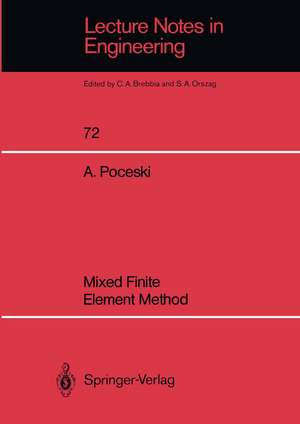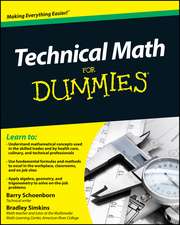Mixed Finite Element Method: Lecture Notes in Engineering, cartea 72
Autor Apostol Poceskien Limba Engleză Paperback – 17 dec 1991
Din seria Lecture Notes in Engineering
- 15%
 Preț: 640.37 lei
Preț: 640.37 lei - 15%
 Preț: 643.34 lei
Preț: 643.34 lei - 15%
 Preț: 632.70 lei
Preț: 632.70 lei - 18%
 Preț: 1049.30 lei
Preț: 1049.30 lei - 15%
 Preț: 637.59 lei
Preț: 637.59 lei - 15%
 Preț: 638.89 lei
Preț: 638.89 lei - 15%
 Preț: 637.93 lei
Preț: 637.93 lei - 15%
 Preț: 635.96 lei
Preț: 635.96 lei - 15%
 Preț: 637.78 lei
Preț: 637.78 lei - 18%
 Preț: 957.13 lei
Preț: 957.13 lei -
 Preț: 397.01 lei
Preț: 397.01 lei - 15%
 Preț: 653.79 lei
Preț: 653.79 lei - 15%
 Preț: 638.57 lei
Preț: 638.57 lei - 15%
 Preț: 634.82 lei
Preț: 634.82 lei - 15%
 Preț: 644.18 lei
Preț: 644.18 lei - 15%
 Preț: 635.15 lei
Preț: 635.15 lei - 15%
 Preț: 637.93 lei
Preț: 637.93 lei - 15%
 Preț: 633.19 lei
Preț: 633.19 lei - 15%
 Preț: 653.79 lei
Preț: 653.79 lei - 15%
 Preț: 636.45 lei
Preț: 636.45 lei - 15%
 Preț: 651.02 lei
Preț: 651.02 lei - 20%
 Preț: 645.31 lei
Preț: 645.31 lei - 15%
 Preț: 639.08 lei
Preț: 639.08 lei - 15%
 Preț: 633.19 lei
Preț: 633.19 lei - 15%
 Preț: 655.13 lei
Preț: 655.13 lei - 15%
 Preț: 652.49 lei
Preț: 652.49 lei - 15%
 Preț: 652.81 lei
Preț: 652.81 lei - 15%
 Preț: 643.48 lei
Preț: 643.48 lei - 15%
 Preț: 638.24 lei
Preț: 638.24 lei - 20%
 Preț: 640.51 lei
Preț: 640.51 lei - 15%
 Preț: 675.58 lei
Preț: 675.58 lei - 15%
 Preț: 639.59 lei
Preț: 639.59 lei - 15%
 Preț: 642.18 lei
Preț: 642.18 lei - 15%
 Preț: 638.43 lei
Preț: 638.43 lei -
 Preț: 434.12 lei
Preț: 434.12 lei - 15%
 Preț: 642.68 lei
Preț: 642.68 lei - 15%
 Preț: 647.27 lei
Preț: 647.27 lei - 15%
 Preț: 655.92 lei
Preț: 655.92 lei - 15%
 Preț: 665.73 lei
Preț: 665.73 lei -
 Preț: 411.64 lei
Preț: 411.64 lei -
 Preț: 406.80 lei
Preț: 406.80 lei - 15%
 Preț: 634.68 lei
Preț: 634.68 lei - 15%
 Preț: 650.86 lei
Preț: 650.86 lei - 18%
 Preț: 974.49 lei
Preț: 974.49 lei - 15%
 Preț: 642.68 lei
Preț: 642.68 lei - 15%
 Preț: 635.31 lei
Preț: 635.31 lei - 15%
 Preț: 640.37 lei
Preț: 640.37 lei - 15%
 Preț: 636.45 lei
Preț: 636.45 lei - 20%
 Preț: 659.63 lei
Preț: 659.63 lei - 15%
 Preț: 651.51 lei
Preț: 651.51 lei
Preț: 645.96 lei
Preț vechi: 759.96 lei
-15% Nou
Puncte Express: 969
Preț estimativ în valută:
123.62€ • 134.23$ • 103.84£
123.62€ • 134.23$ • 103.84£
Carte tipărită la comandă
Livrare economică 22 aprilie-06 mai
Preluare comenzi: 021 569.72.76
Specificații
ISBN-13: 9783540549161
ISBN-10: 3540549161
Pagini: 360
Ilustrații: VIII, 345 p.
Dimensiuni: 170 x 242 x 19 mm
Greutate: 0.57 kg
Ediția:Softcover reprint of the original 1st ed. 1992
Editura: Springer Berlin, Heidelberg
Colecția Springer
Seria Lecture Notes in Engineering
Locul publicării:Berlin, Heidelberg, Germany
ISBN-10: 3540549161
Pagini: 360
Ilustrații: VIII, 345 p.
Dimensiuni: 170 x 242 x 19 mm
Greutate: 0.57 kg
Ediția:Softcover reprint of the original 1st ed. 1992
Editura: Springer Berlin, Heidelberg
Colecția Springer
Seria Lecture Notes in Engineering
Locul publicării:Berlin, Heidelberg, Germany
Public țintă
ResearchCuprins
1. Basic Principles.- 1.1. Introduction.- 1.2. The principle of virtual displacements.- 1.3. The unit force theorem.- 1.4. The unit displacement theorem.- 1.5. Energy variational principles.- 2. Fundamentals of the Finite Element Method.- 2.1. Historical development of the method.- 2.2. The concept of analysis by the finite element method.- 2.3. Energetic approaches of development of finite elements.- 2.4. Application of the unit displacement and unit force theorems.- 2.5. Energetic approach by boundary integration.- 2.6. The essence of the method.- 2.7. Isoparametric formulation.- 2.8. The direct method of development of finite elements.- 2.9. The progress of the mixed method.- 3. The Mixed Method in Analysis of Beam Systems.- 3.1. Introduction.- 3.2. Mixed beam element.- 3.3. Analysis of beam systems.- 3.4. Beam on elastic supports.- 3.5. Dynamics of beams.- 3.6. Stability of the beam systems.- 3.7. Coupled action of axial and transverse forces.- 4. Plate Bending Analysis.- 4.1. Rectangular element with independently assumed displacements and moments.- 4.2. Compatible element derived by boundary integration.- 4.3. Rectangular element derived by the direct method.- 4.4. Accuracy of the rectangular elements.- 4.5. Element for analysis of moderately thick plates.- 4.6. Isoparametric formulation.- 4.7. Quadrilateral element.- 4.8. Quadratic isoparametric element.- 4.9. Curved boundary element of complex displacement function.- 4.10. Accuracy of isoparametric elements.- 4.11. Practical application.- 4.12. Dynamics of plates.- 4.13. Stability of plates.- 5. Two-Dimensional Problems.- 5.1. Differential equations of the problems.- 5.2. Shortcomings of the previously developed elements.- 5.3. Rectangular mixed plane stress element.- 5.4. Quadrilateral element.- 5.5. Element ofcurved contours.- 5.6. Convergency and accuracy of the presented elements.- 6. Shells.- 6.1. Differential equations of shells.- 6.2. Mixed rectangular element.- 6.3. Analysis of dome shell.- 6.4. Analysis of cylindrical roof shell.- 6.5. Analysis of cylindrical pipe.- 6.6. Analysis of hyperbolic paraboloid shell.- 6.7. Comments and tasks for further research.- 7. Three-Dimensional Elements.- 7.1. Introduction.- 7.2. Three-dimensional elements.- 7.3. Mixed element of 36 d.o.f..- 7.4. Prismatic element of 36 d.o.f..- 7.5. Reduced three-dimensional element for plate bending analysis.- 7.6. Analysis of thick plates.- 7.7. Further development of three-dimensional elements.- 8. Further Development of the Finite Element Method.- 8.1. From one-dimensional to two-dimensional elements; accuracy.- 8.2. Displacement interpolation function.- 8.3. On the degrees of freedom.- 8.4. Some remarks on the application of the energy variational principles.- 8.5. The mathematical (direct) approach of development of finite elements.- 8.6. Application of the FEM for solution of different problems.- 8.7. Further development of the mixed method.- References.









